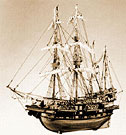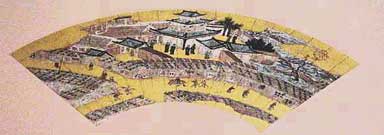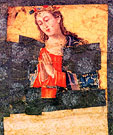- HOME |
- NEWS |
- HISTORY |
- CHURCH |
- WHO ARE WE?
"Laudate" English Page
History of the Japanese Catholic Church
4. Ieyasu Tokugawa and the Christians
After the death of Hideyoshi Toyotomi, Ieyasu Tokugawa had the control of the government, and the feudal government by the Tokugawa family lasted almost 300 years.
Opposition between William Adams and the Catholic Church.

In 1600 (year Keicho 5), the Dutch ship De Liefde, coasted in Bungo. Ieyasu Tokugawa, one of the five important personnel in Toyotomi government, asked the English captain William Adams to become his follower.
At that time Netherlands and England were Protestant countries and had a feeling of hostility for Catholics.
As for the Japanese Catholic church, people were afraid that Adams would give some wrong preaching to Ieyasu, and asked to punish all the crew members of De Liefde and sent a priest to convince him to leave Japan. As a last method, they asked Adams to convert from Protestant to Catholic, but ended in failure.
In this situation, the hostility of Adams towards Catholic missionaries and the Portuguese, aroused suspicion in Ieyasu.
Adams who had been enduring provocation from the Catholic Church, finally had a chance to counterattack. In 1611, a Spanish delegation came to Japan and measured various Japanese ports. When Ieyasu asked Adams the reason for this, he gave the following answer: " Spain will first send *1 Mendicant orders to Japan, and then the army. This is their way of ruling other countries. That is why they first had to measure the ports to know which ship can coast. " So, you should send all missionaries outside the country.
Ieyasu's political policy in the beginning
When he first got the political power, he allowed the Christian propagation and simply ignored it. Missionaries of the Society of Jesus who had already been active in Japan, together with the Franciscans, Dominicans and Augustinos came to Japan.
Ieyasu, because of the foreign affair needs, ignored these activities, but on the other hand did not do anything about the prohibition of religion by Hideyoshi, and had no intention of accepting the Christianity.
Development of the church.

Until the prohibition of the Christianity ten years later, it was for the church a period of prosperity and development.
In 1601 (year Keicho 6) they rebuilt a Jesuit church. In this church, two first Japanese priests have been ordained. There were many social welfare activities by the people. The group "Misericordia" founded in 1583 had a hospital, another institution and was active in giving financial and emotional assistance to the poor.
Omura, Arima and Amakusa became like Christian countries. Especially the church of Arima was one of the most prosperous in Japan. *2 As the Seminario had always been in Arima, the influence was great for the education of people.The students of the Seminario counted more than 100 people. And people from *3 Dojuku also came back to Seminario for retreats and studies.
It was also in Kyoto that the first Japanese convent for nuns appeared. These nuns were called the "Christian Bikuni" and had a fervent prayer life. At the same time, they could go visit and preach to the ladies from the high society, where the priests and brothers could not go.
Way to the prohibition of religion.
Ieyasu who sort of ignored the Christianity, had a sense of crisis through the following incident.

・Incident of Madre de Deus
In 1608, a "red stamped" ship of Christian feudal lord Harunobu Arima went into the port of Macao. Then the crew of the ship and the Portuguese people had a fight, and more than 60 Japanese had been killed.
The following year, Andre Pessoa who was present at this incident, came to Nagasaki aboard the Madre de Deus, and tried to explain the situation to Ieyasu. Yasuyuki Nagasaki and Sahee Hasegawa who heard about the incident, wished to become their attorney in front of Ieyasu.
Ieyasu, ordered Harunobu Arima, to call Pessoa, but Pessoa refused and tried to leave the port aboard Deus. Arima, together with Hasegawa, attacked Deus, by surrounding, and on the fourth day, this ship sank.
・Incident of Daihachi Okamoto
After fighting in this Deus incident, Harunobu wished to bring back the territory to Arima, the territory which he lost during the era of Toyotomi.
At that time, Daihachi Okamoto, who was close to Masazumi Honda, made up a story that Ieyasu was willing to give the old territory as a sign of gratitude to Harunobu.
Daihachi was a Christian, and as he was under Hasegawa in the incident of Deus, Harunobu trusted him. Harunobu sent bribes of big amount to Daihachi, and requested the mediation. However, Harunobu being suspicious, talked to Masazumi Honda directly , and then discovered the forgery of Daihachi.
In 1612, Daihachi has been executed and Harunobu being expelled to the country of Kai was executed later.
As the people concerned were Christians, Ieyasu felt that he could no longer leave the Christians unattended and alone.
After this, he expressed the prohibition of the Christianity and the prosecution. As a result Joan Mondo Hara and *5 Julia Otaa, among others had been dismissed from their post and expelled.
Beginning of persecution.

In 1614,(Keicho 18) the prohibition of Christianity and expulsion of foreign missionaries have been ordered all over Japan. This was the beginning of the severe and long persecution from the end of the feudal government until Meiji era.
・Expulsion of all the priests.
In 1615 (Keicho 19) all the foreign missionaries, *4 Ukon Takayama and nuns had been sent to Nagasaki, and other 400 Christians had been sent to Manilla and Macao, divided into several ships.
A few among them, managed to get back to Japan, and gave their life in missionary work but most of them ended in martyrdom.
Annotation.
- *1 Mendicant orders
-
According to the gospel of Christ, these religious lived a life of love and service to others, not having any personal belongings. And they had to live upon alms for any living needs. There are Franciscans, Dominicans and Augustinos, etc.
- *2 Seminario
-
School of theology for elementary school, junior high and high school children.Formation institution for Jesuit missionaries.Not only missionaries, but they trained musicians and painters as well.In 1579 (year Tensho 7) the first Japanese Seminario has been built in Arima.The first students were 22, among them there were Miguel Chijiwa Julien Nakaura and Martino Hara who later were in the delegation sent to Europe.
- *3 "Dojuku"
-
This first was a Budhist word, but by Valignano S.J. it was used to for something similar. It was for interpreters for foreign priests, preaching homily and explaining doctrine and for celebrating Mass.
- *4 Ukon Takayama
-
(Please see the Tensho Keno Delegation of Youth)
- *5 Otaa Julia
-
A Christian born in Korea. During the Korean invasion of Hideyoshi, still young Otaa has been protected by a Christian Yukinaga Konishi. Influenced by his wife, she became a Christian and got baptized in the name of Julia. After the battle of Sekigahara, she served in the house of Ieyasu Tokugawa. But in 1612, she has been expelled to Kozushima in Izu during the prohibition of religion At the present, every year in May, the Julia festival is celebrated in Kozushima, by Koreans and Japanese in memory of Otaa who had been a witness of God's love.
Copyright (C) 2007-2009 Daughters of St.Paul, Japan. All Rights Reserved.